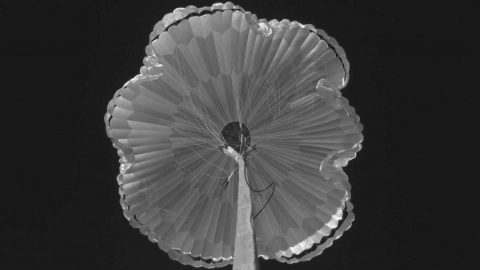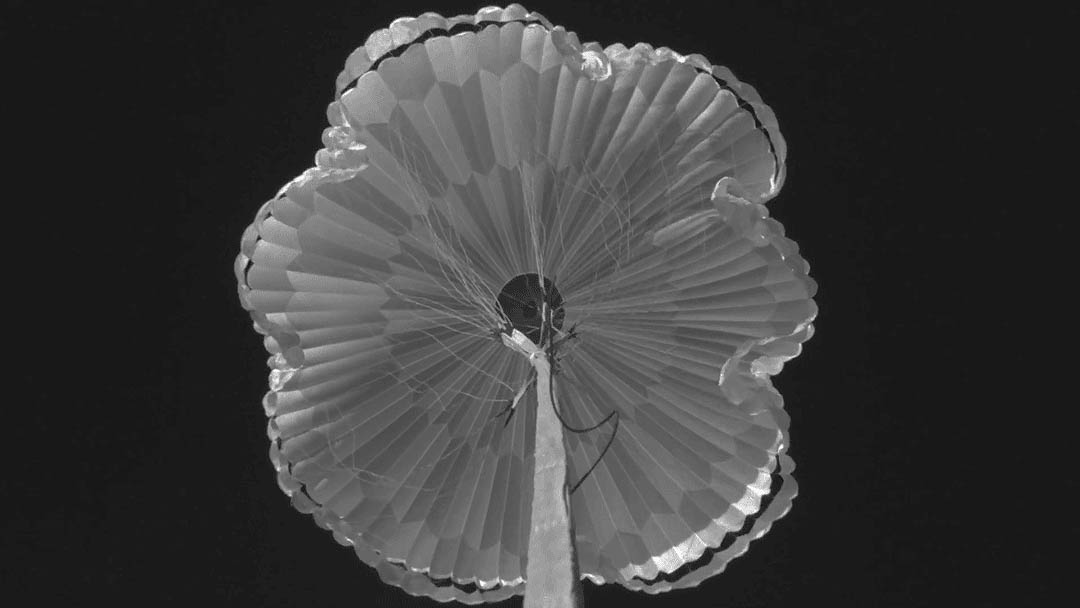NASA’s Jet Propulsion Laboratory
 Pasadena, CA – In the early hours of September 7th, 2018 NASA broke a world record.
Pasadena, CA – In the early hours of September 7th, 2018 NASA broke a world record.
Less than 2 minutes after the launch of a 58-foot-tall (17.7-meter) Black Brant IX sounding rocket, a payload separated and began its dive back through Earth’s atmosphere. When onboard sensors determined the payload had reached the appropriate height and Mach number (38 kilometers altitude, Mach 1.8), the payload deployed a parachute.
Within four-tenths of a second, the 180-pound parachute billowed out from being a solid cylinder to being fully inflated.

It was the fastest inflation in history of a parachute this size and created a peak load of almost 70,000 pounds of force.
This wasn’t just any parachute. The mass of nylon, Technora and Kevlar fibers that make up the parachute will play an integral part in landing NASA’s state-of-the-art Mars 2020 rover on the Red Planet in February 2021.
The NASA Jet Propulsion Laboratory’s Advanced Supersonic Parachute Inflation Research Experiment (ASPIRE) project conducted a series of sounding rocket tests to help decide which parachute design to use on the Mars 2020 mission.
Two different parachutes were evaluated during ASPIRE. The first test flight carried almost an exact copy of the parachute used to land NASA’s Mars Science Labo
On October 3rd, NASA’s Mars 2020 mission management and members of its Entry, Descent, and Landing team met at JPL in Pasadena, California, and determined that the strengthened parachute had passed its tests and was ready for its Martian debut.
“Mars 2020 will be carrying the heaviest payload yet to the surface of Mars, and like all our prior Mars missions, we only have one parachute and it has to work,” said John McNamee, project manager of NASA Mars 2020 at JPL. “The ASPIRE tests have shown in remarkable detail how our parachute will react when it is first deployed into a supersonic flow high above Mars. And let me tell you, it looks beautiful.”
The 67,000-pound (37,000-kilogram) load was the highest ever survived by a supersonic parachute. That’s about an 85-percent higher load than what scientists would expect the Mars 2020 parachute to encounter during its deployment in Mars’ atmosphere.
“Earth’s atmosphere near the surface is much denser than that near the Martian surface, by about 100 times,” said Ian Clark, the test’s technical lead from JPL. “But high up – around 23 miles (37 kilometers) – the atmospheric density on Earth is very similar to 6 miles (10 kilometers) above Mars, which happens to be the altitude that Mars 2020 will deploy its parachute.”
“We are all about helping 2020 stick its landing 28 months from now,” said Clark. “I may not get to shoot rockets to the edge of space for a while, but when it comes to Mars – and when it comes to getting there and getting down there safely – there are always exciting challenges to work on around here.”
The Mars 2020 project’s parachute-testing series, ASPIRE, is managed by the Jet Propulsion Laboratory, with support from NASA’s Langley Research Center in Hampton, Virginia, and NASA’s Ames Research Center in Mountain View, California, for NASA’s Space Science Mission Directorate.
NASA’s Sounding Rocket Program is based at the agency’s Wallops Flight Facility on Wallops Island, Virginia. Northrop Grumman provides mission planning, engineering services and field operations through the NASA Sounding Rocket Operations Contract. NASA’s Heliophysics Division manages the sounding-rocket program for the agency.



